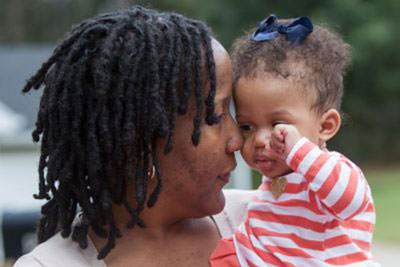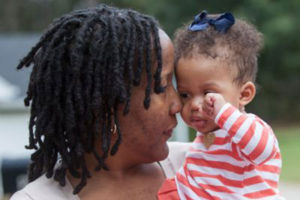
 Black women disproportionately suffer complications of pregnancy and childbirth. Let’s talk about it.
Black women disproportionately suffer complications of pregnancy and childbirth. Let’s talk about it.
We started with 10 women who faced six different maternal complications
By Adriana Gallard, ProPublica
About 700 to 900 women die each year from causes related to pregnancy and childbirth. And for every death, dozens of women suffer life-threatening complications. But there is a stark racial disparity in these numbers. Black mothers are three to four times more likely to die than white mothers. Nevertheless, Black women’s voices are often missing from public discussions about what’s behind the maternal health crisis and how to address the problems.
It is estimated that up to 60 percent of maternal complic-ations are preventable. One way to prevent them is to talk to and learn from women who have nearly died from these complications. So, we reached out to nearly 200 Black mothers or families that shared stories of severe complications as part of our maternal health investiga-tion Lost Mothers.
Since this disparity has existed for decades, we were in-terested in learning how it might have affected genera-tions of Black women — and maybe even women in the same families.
We also know difficult con-versations can sometimes be easier with a loved one. We asked women if they would be willing to discuss their near miss with their mother or daughter.
To help navigate these tough conversations, we gave each pair of women a tailored set of questions and got out of the way (you can download a copy of the questions here). We spent an hour recording them, some in their living rooms and others over the phone. We’ve organized these conversations by the complications each woman faced. We included several generations of women from six to 64-years-old.
Postpartum Hemorrhage
A postpartum hemorrhage (PPH) occurs when a woman experiences heavy blood loss after giving birth. In developed countries, pregnant women nearly die from this complication more than any other. The most common cause of PPH is uterine atony, which means the uterus isn’t contracting effectively after delivery. However, having fibroids (benign tumors in the uterus), any kind of infection or a systemic blood clotting disorder can also cause PPH.
Heather Dobbs was 41 weeks pregnant when she went into a prolonged labor. Eventually she was induced and had an emergency cesarean section at a hospital near her home at the time in rural Texas. Dobbs, 37, an educator and editor now living in Covington, Georgia, says there were no further complications. After the C-section, both Dobbs and her new son Cameron were fine and went home.
Two years later, in 2016, Dobbs was pregnant again. Because of her emergency C-section with Cameron, she was scheduled for another C-section and could plan the birth of her second child. She picked Feb. 8. It was two days before her own birthday. Dobbs was excited and felt prepared to welcome her first daughter, Claire, into the world.
Then came the uterine atony. During her C-section, her doctors said her uterus was “boggy” — it was soft, enlarged, floppy and would not contract as it was supposed to. It also wouldn’t stop bleeding.
Heather: Listen They were just bringing fluid after fluid, after fluid bag, and I finally said to myself: You cannot die on this table before you get to hold your daughter. And that’s the last thing I remember.
Claire was born healthy. But Dobbs’ postpartum hemorrhaging — as a result of uterine atony — forced the doctors to perform a full hysterectomy.
Heather: Listen And then, the doctor came in to talk about the hysterectomy with me. And, I just remember … you know how you watched Charlie Brown, and it’s like, womp womp womp womp womp womp. It’s like, what is she saying? I knew it was serious, but they had to eventually call her back in to re-explain. “You were bleeding out. You lost a tremendous amount of blood, and you had to … We had to take your uterus.
The emotional toll of the hysterectomy and the complication that caused it led to postpartum depression. The support of her mother — Avis Glover, 63, a career nurse, who had two C-sections herself — has been important in her recovery.
Avis: How do you manage, you think, with the long-term effects of your experience?
Heather: Listen At my darkest hour, it was like why plan anything? Everything’s just going to go however it goes anyway. You don’t have any control, so that was really difficult. But then at the same time, it made me aware, you have two kids that you have to care for now. And in caring for them, you must care for yourself, so you can’t have the anxious mom, and the depressed mom, you have to treat it.
Did you suffer postpartum hemorrhage? Tell us.
Fibroids and Preeclampsia
Fibroids are benign tumors in the uterus. They are most common in 30- to 40-year-old women. Fibroids, however, are three times more likely to occur in Black women than white women. They also tend to occur at younger ages and grow more quickly in Black women, causing more severe symptoms — like heavy menstrual bleeding and pelvic pain — contributing to complications such as postpartum hemorrhage.
Preeclampsia occurs when a woman with normal blood pressure develops high blood pressure during pregnancy and when protein is found in the urine. Left untreated, preeclampsia can lead to other serious complications for both the mother and the baby. Preeclampsia affects at least 5 to 8 percent of pregnancies. When Black women have preeclampsia, it presents earlier than in women of other races.
Asha Ivey-Stephenson, 37, and Wanda Irving, 64, became friends through Wanda’s daughter, Shalon Irving. The three first met in Michigan in 2002 while Asha and Shalon visited graduate school programs they were interested in attending. Years later the friends reconnected in the Atlanta area where they both settled. Close in age, both wanted to become mothers. Ivey-Stephenson would be the first. She got pregnant in 2015 when she was 35 years old. Ivey-Stephenson has fibroids, a complication that affects 80 percent of black women. No one knows what exactly causes fibroids or why Black women are so susceptible.
Ivey-Stephenson’s fibroids kept her in the high risk perinatal unit for a month and a half. Her stay was so long that Ivey-Stephenson had her baby shower at the hospital. In mid-December she delivered a healthy baby boy.
Asha: Listen This is something that Shalon and I actually bonded over. She helped motivate me through as well. My challenges that I was referring to primarily stemmed from my uterine fibroids and it’s something that African American women deal with. The majority of my friends have, whether it’s small, large, multiple fibroids. It’s something that my mother had, so I knew that most likely I’d have it.
Five days after she delivered, just as she was about to leave the hospital, Ivey-Stephenson’s blood pressure skyrocketed.
Asha: Listen There were points where [my blood pressure] got so high, we were all not sure what was going to happen. When I got home, I had to have physical therapy, occupational therapy and regular nursing. Occupational therapy and regular nursing came to the house because I had lost so much muscle tone. Basically I couldn’t walk. So I had to learn all that over again.
And it was just, trying to do that plus trying to breastfeed, trying to do all these different things was challenging.
During all of this, Irving was part of her network of supportive friends.
A little over a year later, in January 2017, Irving celebrated the birth of her first child — a baby girl she named Soleil. But Irving was a mother for just three weeks. Her postpartum
complications became increasingly serious. She ultimately died due to complications from high blood pressure. Soleil was left in the care of Irving’s mother, Wanda. Ivy-Stephenson has stayed close to the family. Wanda sat down with Ivey-Stephenson to share this conversation, and her advice for other expectant black women.
Wanda: Listen My one regret is that Shalon told me once, she says, “I know my body. I know there’s something wrong,” and that’s what I would recommend to every black woman, if you know there’s something wrong, please don’t stop until you find someone who will help you figure out what’s wrong, and not just take a lot of the paternalistic kinds of answers or the general answers, “Oh well it’s nothing. It comes along with pregnancy,” or “It’s part of childbirth,” or it’s part of whatever. You know your body better than anyone else. You live in that body. If there is something you’re feeling that’s wrong, then do something.
Did you suffer fibroids or preeclampsia? Tell us.
Uterine Rupture
A uterine rupture is a tear in the wall of the uterus. While rare, this complication is dangerous not just for the mother but for the child. When the uterus tears, the unborn baby can be expelled into his or her mother’s abdomen. The baby can be deprived of oxygen and the mother can experience severe blood loss. A well-known risk factor for a uterine rupture is a uterine scar. Most uterine scars arise from a prior cesarean delivery.
In March 2014, Heather Lavender was 32 and nine months pregnant when she went into labor. Her mother, Brenda Bagby, her sister, Melissa, her doula, and her son’s father rushed Lavender to Johns Hopkins Hospital in Baltimore where she was also an intensive care nurse.
After many hours of labor, she had a pain in her abdomen, which gradually became unbearable. That pain turned out to be a uterine rupture. After an emergency C-section to deliver the baby, doctors had to perform a hysterectomy to stop the massive blood loss.
Heather: Listen You know as long as my baby is OK, you know … God can’t be that cruel to have me lose my uterus and my baby all at the same time. So at that point I was just really hoping and praying that my son would be OK.
The rupture, however, was catastrophic for her son. Cruz ended up outside of the womb and without oxygen. As a result, he suffered severe brain damage. When Cruz was born he never moved, opened his eyes or cried.
Brenda: How are you different now than before your complication?
Heather: Listen I think for most of my life I’ve been a pretty positive person and I just don’t feel that way about myself anymore. I feel purposeless, I don’t feel that I have like true joy in my life, I don’t care. I pray for an early death. I don’t want to live to be an old person … and I know it’s wrong.
Cruz lived nine days on a ventilator in the neonatal intensive care unit before Lavender and her family decided to remove him from life support.
Heather: How do you remember my son Cruz, your grandson?
Brenda: Listen It’s hard sometimes, I couldn’t stand the sound of the machinery after a while. I just wanted it to stop, I didn’t want to hear more beeping. No more alarms. So I am glad we got to have a little bit of time without all of that. And when they extubated him, when they removed him from the breathing tube it was clear that he wasn’t going to be able to be with us for very long. So being able to go home and have that quiet time with him that we wouldn’t have had otherwise was really a blessing and having the pictures that we have from that helps me every day.
In 2016, Lavender moved from Baltimore, Maryland, to Farmington, New Mexico. This conversation was recorded during a visit from her mother who lives in Cleveland Heights, Ohio. Lavender continues to practice as a nurse.
Did you suffer a uterine rupture? Tell us.
Spontaneous Coronary Artery Dissection
Spontaneous coronary artery dissection, or SCAD, often occurs late in the pregnancy or during the postpartum period. It’s when a tear forms in one of the blood vessels in the heart. It can slow or block blood flow, causing a heart attack, abnormalities in heart rhythm or sudden death. Hormonal changes during pregnancy are thought to trigger this complication. Despite treatment, it may recur soon after the initial tear or even years later.
As in most SCAD cases, Candice Williams, a high school teacher, was healthy throughout her pregnancy. She was 30 at the time. She did not have a heart condition or a previous history of hypertension. But five days after giving birth to her first child, Aniston, in 2011, she nearly died.
Aniston is now 6 years old and wanted to ask her mother this:
Aniston: How did you get your heart attack?
Candice: Listen That’s a good question baby, doctors aren’t really sure. I’ve seen at least four doctors related to the heart attack and all they can tell me is that it is a rare occurrence and that it has something to do with my hormones so when I had you my hormones were unstable as women’s hormones are after they give birth so I guess that caused my heart to start hurting baby but it wasn’t your fault.
Williams, now 37, was home from the hospital when her chest started to hurt. The pain got so bad that her mother, LaVerne Maynard, rushed Williams to a nearby hospital in El Centro, California. Because that hospital wasn’t equipped to treat Williams, she was airlifted more than 100 miles to a hospital in San Diego.
LaVerne: What is the hardest moment for you?
Candice: Listen The hardest moment was probably being life-flighted and I only remember parts of it, I guess I was really scared and I kept thinking about Ani and if I … if something happened to me, I had no idea what was going to happen to my baby. So that was the hardest moment. It’s still the hardest moment.
After more tests, doctors concluded that she had experienced a SCAD. Rather than operate on her, they gave her blood thinners, beta blockers and aspirin to prevent another attack and help heal the heart on its own. She was hospitalized for four days and released.
Candice: Listen I had a relatively good diet, I was not overweight and SCAD often happens to women who don’t have any prior health issues. So people think because I had a heart attack that I had high blood pressure or I didn’t eat right or didn’t exercise but I was actually the opposite of that.
After surviving this SCAD, her doctors advised against a second pregnancy. But, five years later, in March of 2016, Williams gave birth to a second daughter, Leah. This time, she had no complications. Williams pays more attention to her body now. She takes blood pressure medication once a week, sees her cardiologists every six months, exercises, and watches what she eats.
Did you suffer a SCAD? Tell us.
Peripartum Cardiomyopathy
Peripartum cardiomyopathy (PPCM) is a form of maternal heart failure. It’s when the heart isn’t strong enough to pump enough blood to the vital organs so they can function properly. A mother may experience PPCM up to six months postpartum. On average, PPCM affects Black women at a younger age (27.6 years old) than non-Black women (31.7 years old). And despite similar rates of treatment, the recovery time for African American women was at least twice as long as that of other women. Little research has been done to understand the differences in severity and recovery.
In 1992, about a month after Anner Porter gave birth to her second child — a boy she named Norris — she was at the OB-GYN complaining of exhaustion and numbness. She said she was told to eat some beets to improve a low iron count. Two days later, Porter nearly died. Her heart failed to pump enough blood to keep her vital organs going. This is called postpartum cardiomyopathy (PPCM).
That was the first time Porter had heard of PPCM — from an emergency room doctor diagnosing it as her organs started to shut down. Ever since that postpartum heart failure 25 years ago, Porter has suffered heart complications.
Jennifer: Tell me what happened in the postpartum period that changed your life?
Anner: Listen Oh wow, OK. Twenty-eight days later I still found it extremely difficult to function. I was extremely fatigued. Was constantly experiencing shortness of breath. Coughing all the time unable to lie down, heart palpitations, I had significant weight gain, excessive swelling in my legs, belly, feet, ankles. I remember each day became unbearable and each night became a nightmare. At that point I knew something was wrong with my body.
In the years since the cardiomyopathy, she has needed two separate heart procedures: a defibrillator implanted in 2010, and open-heart surgery after a silent heart attack in 2012.
Anner: Do you look at your own life differently?
Jennifer: Listen Yes, I do. Seeing how something simple can — like childbirth — put so much stress on your body and seeing everything that you went through in terms of how you drastically had to change your diet, how you were going from no medication to five to six different medications, how your body reacted. Seeing how different stress in certain activities in life you couldn’t do in terms of like walking up the stairs, you couldn’t do. How little things like driving, you used to lose your breath and you used to have that plastic bag … not plastic … paper bag in your purse in case something happened, you had that, so yeah it has changed my life.
While the cause of PPCM remains unknown, Porter believes awareness among women and clinicians can save lives.
Anner: Listen I don’t want any other woman to experience a near-death pregnancy like I did, I feel that I must continue to bring awareness about this deadly disease that actually has no cure in sight.
To raise awareness, Porter founded the nonprofit organization Fight Against Peripartum and Postpartum Cardiomyopathy. She is the author of the 2011 book “Peripartum and Postpartum Cardiomyopathy: A Cardiac Emergency for Pregnant Women” and host of the podcast “Cardiac Emergency For Pregnant Women.”
Did you suffer a PPCM? Tell us.
Get Involved
These vignettes are snippets of hours-long conversations. The women talked with each other about their formative years, their painful memories of death or near death, and the advice they would give to expectant and new mothers. Often, what they heard from their loved ones surprised them.
If you’d like to facilitate your own conversation with your mother, daughter or granddaughter, we have written a list of questions. We encourage you to use them and record your own conversations.
Here’s how:
- Download or print out this form with our suggested questions. But also feel free to make it your own.
- Find a quiet space to record. We encourage you record this conversation using your phone or a digital recorder.
- Feel free to share anything with us at maternal@propublica.org. Privacy note: nothing will be published without your permission
By Adriana Gallard
If you have any questions about having your own conversation and documenting it, email us at maternal@propublica.org.
Do you know someone who died or nearly died in childbirth? Help us investigate maternal health.
This story was originally published by ProPublica





Be the first to comment